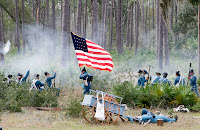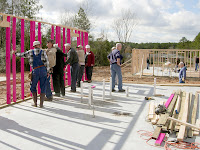"Hey, Houston, we've had a problem here."
-- James A. Lovell, Jr.
Location: Day Trip To Houston
This is the real quote, rather than the often misquoted, "Houston, we have a problem," that began the nightmare of cascading failures for Apollo 13 and Houston Mission Control in April 1970. And I know this because it is displayed at Space Center Houston, which is half astronomy lessons, half real-time NASA Mission Control, and half hands-on science center (math majors, you may wince here). As you drive through the outskirts of Houston, you start to think that "NASA" must be the name of the town -- there is the NASA Souvenir Shop, the NASA Shell Station, the NASA Liquor Store, the NASA One Cleaners, and the NASA Pointe Mall.
Although the NASA name predominates, Space Center Houston is the jumping off point all things spacey in the area. It is here that you buy your ticket, go through a security checkpoint, and then choose whether you want to go to the theaters, galleries, displays, hands-on activities, eat spacey food or -- of course -- visit the gift shop. That was an easy decision for me -- a guided tour through the real NASA's Johnson Space Center topped my list.
I got in line for the tram tour, which began with someone taking the seemingly ubiquitous photo of each of us -- the photo that we would be able to purchase for a mere $20 at the conclusion of the tour (I declined). We had gone through a security checkpoint to get into Space Center Houston, but that had not been much more than a cursory purse and bag check. To get to the Johnson Space Center, however, we had to go through a metal detector, and we were issued a pass that we had to retain for the tram. There were three stops where we would exit the tram and tour a building -- and we were required to sit in the same seats every time we returned to ensure that no one was missing. We also found out that our souvenir pictures served a dual purpose -- they were a record of the people on each tram in case security was breached. Oddly, we got to keep our shoes on, and were allowed to take liquids with us!
 We stopped first at Mission Control. We were able to visit the actual, in-use-today Mission Control because it was a weekend and it was empty, but we could only see it from behind glass. Had our tour been during working hours, we would have visited a mock up of the historic Mission Control instead. We then visited a large, long room with mock-ups of the shuttle and every conceivable lab and module, but, again, it was behind glass. This room is used for astronaut practice and training. At our final tram stop we saw a huge Saturn V Rocket, laying on its side and taking up the entire length of an enormous bunker. This was the one thing that was not behind glass, probably because there isn't much one could do to hurt or enable it.
We stopped first at Mission Control. We were able to visit the actual, in-use-today Mission Control because it was a weekend and it was empty, but we could only see it from behind glass. Had our tour been during working hours, we would have visited a mock up of the historic Mission Control instead. We then visited a large, long room with mock-ups of the shuttle and every conceivable lab and module, but, again, it was behind glass. This room is used for astronaut practice and training. At our final tram stop we saw a huge Saturn V Rocket, laying on its side and taking up the entire length of an enormous bunker. This was the one thing that was not behind glass, probably because there isn't much one could do to hurt or enable it.
When I got back, I had time to do a few of the other Space Center Houston activities. The one I liked best was the gallery of spaceships, some the real vehicle, and some re-creations. Mercury, Gemini, and Apollo capsules were there, and looking very small and claustrophobic. The Moon rover looked like a fun ride, and the SpaceLab mock up was remarkably livable.
 There also were moon rocks and core samples, all real, and a lab to study them, totally fake, including a mannequin researcher meticulously working on real moon samples. There were several moon rocks on display, and we could reach under a glass partition and actually touch a small piece of one. It was interesting to see the moon rocks, but my favorite artifact was the lunar soil. It was only a couple plastic bags filled with what looked like shimmery black sand, but I couldn't help but think how it must have felt to have walked on it, rolled in it, been covered with it, and then to have left it behind.
There also were moon rocks and core samples, all real, and a lab to study them, totally fake, including a mannequin researcher meticulously working on real moon samples. There were several moon rocks on display, and we could reach under a glass partition and actually touch a small piece of one. It was interesting to see the moon rocks, but my favorite artifact was the lunar soil. It was only a couple plastic bags filled with what looked like shimmery black sand, but I couldn't help but think how it must have felt to have walked on it, rolled in it, been covered with it, and then to have left it behind.
 Years ago, I was looking at a book of NASA moon images, and ran across an image of Eugene Cernan resting after a moonwalk. While the picture is a bit out of focus, the look on his face says it all -- he has walked on the moon and is -- amazingly -- covered with moon dust. It is a moment unlike any other. I have never forgotten that picture.
Years ago, I was looking at a book of NASA moon images, and ran across an image of Eugene Cernan resting after a moonwalk. While the picture is a bit out of focus, the look on his face says it all -- he has walked on the moon and is -- amazingly -- covered with moon dust. It is a moment unlike any other. I have never forgotten that picture.
We got a brief talk on the future -- a return to the moon by 2020, and a Mars landing by 2030. Someone who is alive now, but under 30 years old, will be the first person to walk on Mars. I have to accept that it won't be me, but I hope at least someday I can hear that person's description of what standing on Mars was like, and maybe even see a plastic bag or two filled with red martian sand. It's not the same as being there, but I'll take what I can.
 On my last day in this park, the Barred Owl I have been searching for showed up! And I heard his story from some folks who were staying here last year:
On my last day in this park, the Barred Owl I have been searching for showed up! And I heard his story from some folks who were staying here last year: 
















































